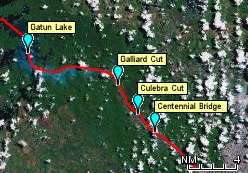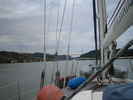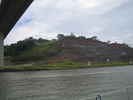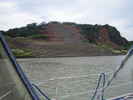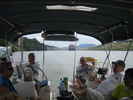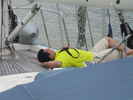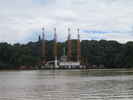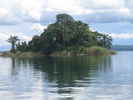Gaillard/Culebra Cut and Lake GatunInasmuch as we were doing so well time-wise, Larry told me to use full power, and put the "pedal to the metal" for the 30 mile Gatun Lake passage to the Gatun Locks. So I cranked RHAPSODY up to 2400 RPMS and was pushing 8 knots, but she started getting a little hot, so I backed off to 2100 RPMS and we made a stately 7.4 knots as we proceeded. Soon we passed under the "Centennial Bridge". This is where we passed through the famous Gaillard Cut, named after the American Engineer who finally got through it (also named Culebra Cut,"Snake" in Spanish, for its original winding course). Some 25,000 men from many nations died in the 40 years that the Canal construction took, first under the French, and then the Americans, particularly to dig this trench through the highest part of the Canal. Originally the French had thought to build a sea-level canal, without locks, all the way across the peninsula, like the Suez Canal, but the amount of work involved, and the cost in money and human life was too high. Unlike the Suez, which was essentially a flat arid piece of land that had to be cut through, the Panama Canal goes through hills and canyons made of every kind of rock. But the real killer here was the Yellow Fever and Malaria that was brought on by the mosquitoes which thrive in the wet tropical climate. The Panama Canal was the site of the largest, most innovative sanitation and pest control project in the history of mankind. In fact, it can count many firsts among its accomplishments. The locks were the largest concrete structures ever created by man at the time. Lake Gatun was the largest man-made lake in the world, and Gatun Dam was the largest damn in the world at the time. It has been estimated that the amount of effort used to build the Panama Canal was the equivalent of building 100 pyramids of Egypt. The excavation was enough to have dug a 10 foot deep trench, 30 feet wide, across the entire continental United States. In every way it was a huge effort, and it was very humbling to be here. We passed reinforced "Gold Hill" and "Contractors Hill", as we went through the Galliard Cut. We passed huge dredging machines and machines used to drill holes to place explosives under the canal bed, for the ever continuing maintenance and widening of the Canal. Our crew passed the time by sunbathing, taking naps, and chatting as we made our way between the line of dozens of red and green buoys, large ships coming the other direction passing us every 15 minutes or so. The entire path is lined with thousands of lights, like street lights, that light the whole place up at night. We saw a number of tour boats go by, too, with people who pay $100 or so to be on a boat with 200-300 other folks just to go through the locks. Very, very interesting! By the way, if you're interested in finding out more about the history of the Panama Canal and the fulfilment of this centuries old dream, we highly recommend the book The Path Between the Seas, by David McCullough. It's a great read and was most informative for our once-in-a-lifetime experience. Towards the far side of Lake Gatun, we took a short cut called the "Banana Cut" that is only available to smaller boats like us, and for awhile we were alone in the Canal through wild jungle islets. But finally, after about 4 hours of motoring, around 3:30 pm, we turned a corner and saw a dozen or so big ships at anchor as we came into view of the Gatun Locks. |

